Best Stock Charting Software of 2024
Charting is an integral part of the investment process and assists investors in visualizing fundamental, technical, and macroeconomic data. The best charting software should be powerful, customizable, intuitive, responsive, and cater to a variety of needs to ensure the investor’s workflow is not interrupted. With a myriad of charting tools to choose from, we wanted to highlight the most accessible, intuitive, and affordable charting software available to investors today.
In our comparison, we focus on platforms that meet the most critical demands of investors seeking to visualize market data:
- Global universe: Investors want the world at their fingertips and the freedom to specify which markets and what asset classes they want to dive into. A global database of data is crucial.
- Cross asset: Whether it’s fundamental or technical analysis, FX rates, or macroeconomic data, investors have varying needs. The best charting software should cater to all of them.
- Widely accessible: Web-based, and mostly free, these charting apps are widely accessible and affordable.
- Customizable: Investors should be able to easily apply their desired indicators, compare data series, transform data, and alter the aesthetic of their charts.
- Complementary tools: Charting is great, but investors also need tools to complement their research. Complementary tools inside the same platform such as screening, financials, watchlists, news, macro dashboards, and analyst estimates are important for the next leg of research.
Compare
Koyfin | YCharts | TrendSpider | TradingView | |
Cost of charting | $0 - $39/mo | $3,600+/year | $149/mo | $0 - $499/mo |
Free version |
|
|
|
|
Fundamental charting |
|
|
|
|
Technical charting |
|
|
|
|
Macro data |
|
|
|
|
Coverage | Global | US | US | Global |
Available stocks | ~100,000 | ~20,000 | ~15,000 | ~78,000 |
ETFs and Funds |
|
|
|
|
Koyfin | YCharts | TrendSpider | TradingView | |
Relative charts |
|
|
|
|
Chart in multiple currencies |
|
|
|
|
Intraday charts |
|
|
|
|
ETF Valuations |
|
|
|
|
Data transformation |
|
|
|
|
Chart annotation |
|
|
|
|
Custom chart branding |
|
|
|
|
Scatter charts |
|
|
|
|
10 Best Stock Charting Software
Koyfin
Charting: Koyfin’s charting is best known for its depth in asset class and data series coverage, simple and intuitive design, and strong customizability.
Investors can chart data across stocks, funds, indices, FX, futures, and macroeconomic instruments with an extensive library of indicators to choose from. Customization is Koyfin’s strength. Each data series can be configured in various ways, such as transformations to show rate of change, drawdowns, and performance, altering the indicator type to reflect bar, line, candle, and area charts, color styling, and the ability to add statistical bands to chart standard deviations, means, medians, and ranges.
Comparisons are made easy through Koyfin’s panel design, allowing investors to represent data in a single panel or split them into several. With chart templates, Koyfin allows investors to save preferred views to revisit later or utilize across other areas of the platform such as custom dashboards and snapshots. Koyfin charting has the tools to satisfy both technical and fundamental investors and is priced to suit both individuals and professionals.
New users receive a 7-day free trial of Koyfin Pro without needing to input a credit card.
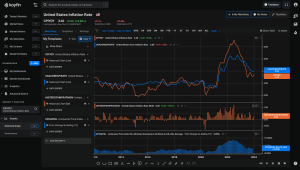
Explore Koyfin Charting: Sign Up Free
Charting Functionality:
Koyfin offers all the key features that both individual investors and financial professionals look for in high-quality charts software.
- Global stock database
- Macro, indices, funds, futures, FX
- Free advanced charting
- Chart templates
- Fundamental charting
- Technical charting
- Cross-asset charts
- Relative charts
- Intraday charts
- Scatter charts
- ETF valuations
- ETF Flows
- Data transformation
- Statistical bands
- Compare data series
- Intervals
- Chart annotation
- Chart in multiple currencies
- Multiple indicator styles
- Custom chart dashboards
- Custom chart branding
Technical Charts
Browse through an extensive library of technical charting with Koyfin, where each indicator can be modified to your unique preferences.
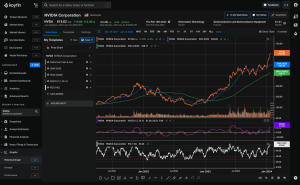
Cross-asset Charts
Cross-asset charts allow investors to overlay data from multiple asset classes to understand their relationship with one another.
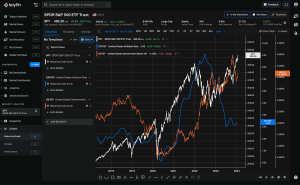
Fundamental Charts
Whether it’s the financial statements, margins, ratios, growth rates, or valuations, Koyfin’s extensive library allows investors to visualize the fundamental trends in equities. Investors can construct charts for individual equities, or seamlessly compare multiple stocks in one chart.
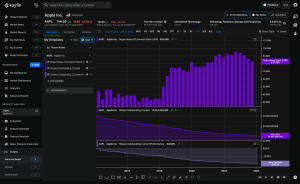
Data Transformations
Koyfin’s charts are highly customizable. Investors can customize indicator styles, colors, branding, gridlines, labels, legends, axis styles, annotations, and transform data series. Each data series inside of Koyfin has a settings table with unique options for customization. Transformations allow investors to convert a data series into a growth rate (notional or percentage), show cumulative performance and rate of change, drawdowns, and more.
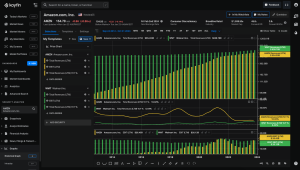
Relative Charts
Relative charts allow investors to express the relationship between two data series to assess relative performance (or relative strength).
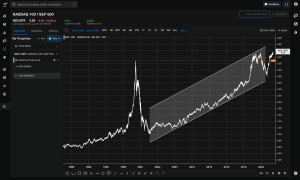
ETF Valuations
In addition to a global library of stocks, Koyfin provides investors with ETF valuation data for US funds which can be charted to show data series like P/E, P/S, EV/EBIT, yields, and more.
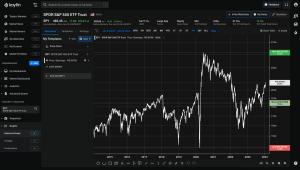
Chart Templates
The beauty of Koyfin’s charting is how interoperable it is with the rest of the platform. Investors can save their screen results as watchlists and use them throughout the platform, dropping their basket of screened stocks into features like earnings calendars, charts, market scatter graphs, custom watchlist news feeds, and more.
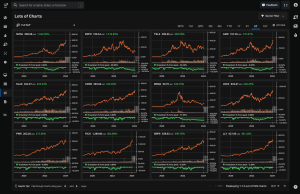
Explore Koyfin Charting: Sign Up Free
Pricing & Plans:
Koyfin offers three pricing plans suitable for a variety of needs. Koyfin’s advanced charting is free with two chart templates for all users.
|
Free |
Plus |
Pro |
|
Free |
$39/month |
$79/month |
|
|
|
|
| • Advanced charting | • Everything in Free | • Everything in Plus |
| • 2 Chart templates | • Unlimited chart templates | • Mutual fund screener |
| • 2Y financials & 1Y estimates | • 10Y financials & 10Y estimates | • US & Canadian mutual fund data |
| • Market & macro dashboards | • Filings & transcripts | • Mutual fund holdings |
| • Global stock screener | • Advanced transcript search | • Full US ETF Valuation data |
| • Watchlists | • Unlimited watchlists | • Unlimited custom formulas |
| • Shareable watchlists | • Unlimited screening templates | • Unlimited custom FA templates |
| • Portfolio tools | • ETF screener | • Model portfolio tools |
| • Economic & earnings calendar | • Custom dashboards | • Priority support |
| • Limited transcripts | • Dashboard data download | |
| • Limited ETF holdings | • 10 custom formulas | |
| • Limited ETF valuations | • Custom FA templates | |
| • Limited company snapshots | • Full ETF holdings data | |
| • Web-based news | • 100k+ global company snapshots | |
| • Premium news & press releases | ||
| • Custom news feeds |
For a custom fit, explore the Enterprise Plan. It includes everything in Pro, plus custom onboarding, administrative purchasing options, single sign-on, and flexible, scalable pricing. Contact the sales team for inquiries.
See a full comparison of Koyfin’s plans and functionality
|
Pros |
Cons |
|
|
|
| • Free advanced charting | • No options data |
| • Global stock universe | • US & Canadian mutual fund data requires a subscription |
| • Technical and fundamental charting | • No bid/ask spreads |
| • Macroeconomic data | • EOD prices for stocks outside US & Canada |
| • Multiple asset classes | • No minute candles |
| • Intuitive design | |
| • Chart templates | |
| • Highly customizable | |
| • Custom chart branding | |
| • Intraday charts |
Koyfin Beyond Charting:
Koyfin is the Swiss army knife of financial research platforms and the best all-around stock screener for individuals and professionals thanks to its incredible breadth and depth in institutional quality data, customizability, and modern user interface. Trusted by more than 500,000 investors, Koyfin delivers a comprehensive financial data terminal at a price that caters to everyone. You can try Koyfin’s screener for free. New users receive a 7-day free trial of Koyfin Pro without needing to input a credit card.
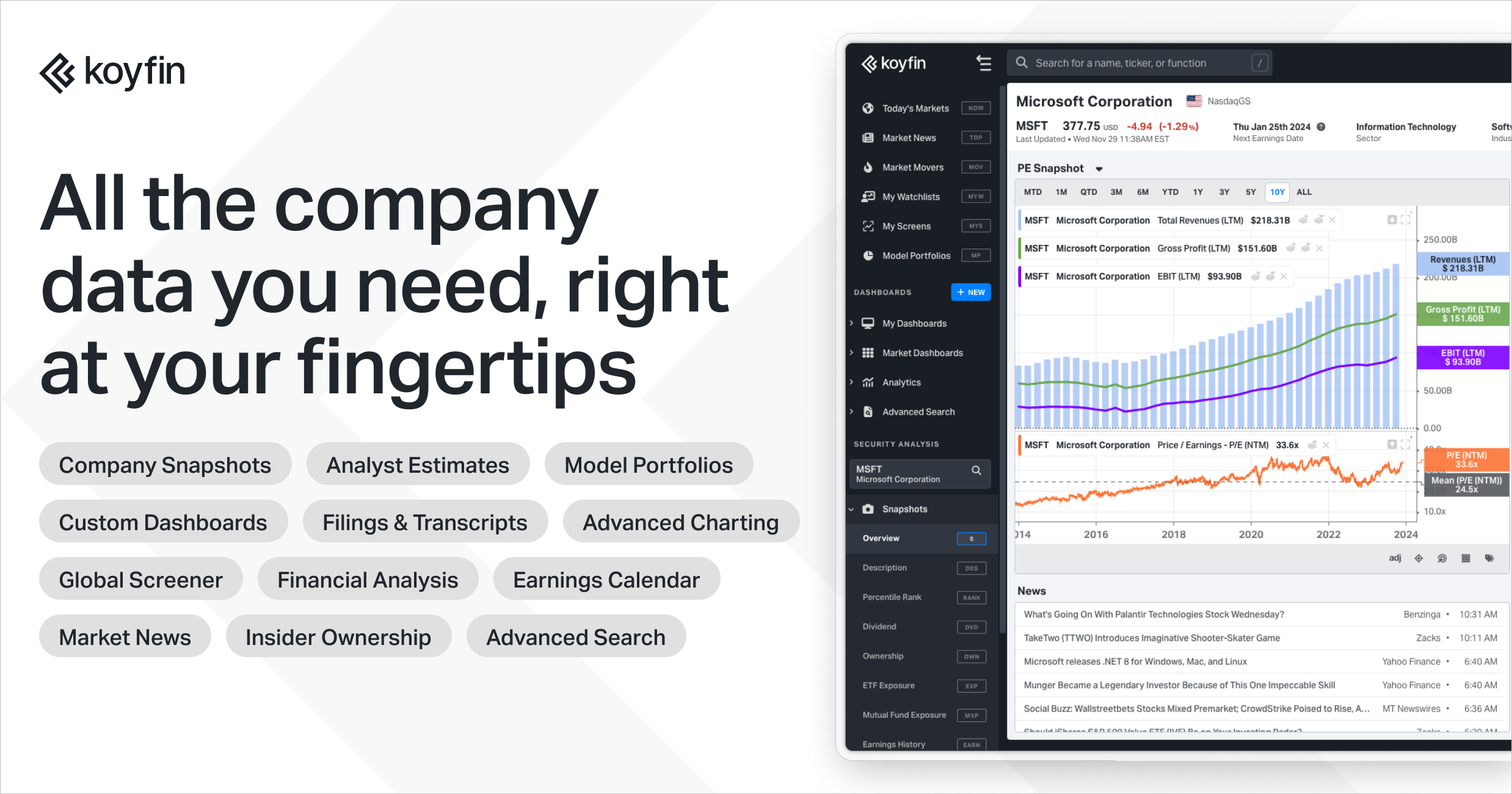
Access Advanced Financial Tools: Sign Up Free
Summary:
Koyfin’s expansive charting capabilities are unrivaled in depth and customizability, offering over 500 unique metrics and thousands of variations. While the range of data is vast, it is organized in a simple and intuitive way. The Koyfin terminal adapts flexibly to an investor’s needs with an extensive catalog of features for conducting a multitude of analyses. The charting tool stands out as one of the strongest features Koyfin has to offer.
- Price advantage: Unrivaled functionality, data, and coverage, all at no cost.
- Highly customizable: Incredibly flexible to an investor’s needs, with a range of methods to control, compare, and visualize the data.
- Intuitive: Simple yet powerful design. Investors can easily accomplish what they set out to do.
- Flexible: Ideal for fundamental and technical analysis, as well as investors seeking to visualize data for macroeconomic data or alternative asset classes.
YCharts
Platform: YCharts is a comprehensive financial platform that offers users a wide variety of market data and investment analysis tools. Its core features include intuitive visualization capabilities, tools for financial analysis and portfolio management, and an impressive depth of macroeconomic data. Given its price point, the platform largely caters to professional advisors, asset managers, and teams with a variety of plans available.
Charting: YCharts has made a name for itself because of their fundamental and macro charting capabilities. The platform offers a deep library of macroeconomic data points as well as US stocks and a limited range of international stocks. Users enjoy YCharts because of the intuitive design and breadth of data.
Functionality:
- Macro data
- Fundamental charting
- Limited technical charting
- Multiple asset classes
- Compare stocks
- Intervals
- Annotation
- Chart templates
- Custom chart dashboards
- Custom chart branding
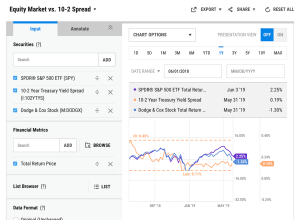
Pricing & Plans:
YCharts offers four pricing plans but doesn’t publicly disclose prices. WallStreetZen, a third-party review site, claims the prices range from approximately $3,600 per year for the entry-level plan to $6,000 per year for the professional plan.
- The full range of charting capabilities is available in the analyst, professional, and enterprise plans, which range from $3,600 to $6,000 per year. The presenter plan does not contain charting.
For more details on the rest of the data in YCharts’ pricing plans, visit their website.
|
Pros |
Cons |
|
|
|
| • Macro data charting | • Very expensive |
| • Technical and fundamental charting | • No international coverage |
| • Simple design | • Limited charting |
| • Custom chart branding | • Not suitable for individual investors |
| • Chart templates |
Summary:
While YCharts is not suitable for individual investors, it serves as a robust platform for professionals and teams, offering standout depth in macroeconomic data as well as a broad range of fundamental charting tools.
TradingView
Platform: TradingView is a popular platform that specializes in charting and technical analysis tools across a variety of asset classes and data sets like stocks, funds, futures, forex, crypto, bonds, and macro. It offers extensive charting capabilities with a vast library of indicators and drawing tools, real-time data, and a community-driven platform where users can share insights and trading strategies. The platform is best suited to active traders.
Charting: TradingView’s charting capabilities generate a lot of hype, and the hype is warranted. Offering charting across a full spectrum of asset classes and macro, TradingView comes equipped with broad customizability, hundreds of technical indicators, annotation tools, real-time data, and a global database of stocks.
Functionality:
- Technical charting
- Fundamental charting
- Macro data
- Multiple asset classes
- Global database of stocks
- Compare stocks
- Intervals
- Annotation
- Multiple indicator styles
- Custom chart dashboards
- Chart templates
- Replay tools
- Custom chart branding
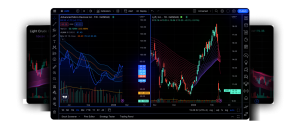
Pricing & Plans:
TradingView offers seven pricing plans and differentiates them by non-professional and professional:
- Basic: provides one chart per tab, over 15 customizable chart types, historical data for all time on daily and higher time frames, and up to 42 days of minute-by-minute data. Users can access over 400 pre-built indicators, with a limit of two indicators per chart.
- Paid non-professional: The essential ($12.95 per month), plus ($24.95 per month), and premium ($49.95) plans vary in charting capabilities. Essential offers 2 charts per tab and 10,000 bars of historical data, Plus provides 4 charts and the same historical bars, while Premium expands to 8 charts and 20,000 bars. Indicator limits per chart are 5 for Essential, 10 for Plus, and 25 for Premium. All plans include features like Bar Replay and data export, with increasing alert options and parallel connections in higher-tier plans.
- Paid professional: The expert ($199.95 per month), elite ($349.95 per month), and ultimate ($499.95 per month) plans offer enhanced charting features. Expert includes 10 charts per tab and 360 days of minute data, Elite provides 12 charts with extended historical data, and Ultimate offers 16 charts with the most extensive data range. Indicators per chart increase across these plans, from 30 in Expert to 35 in Elite and 50 in Ultimate. Historical bars also increase with each plan, offering more depth for analysis.
For more details on the rest of the data in TradingViews’ pricing plans, visit their website.
|
Pros |
Cons |
|
|
|
| • Real-time data | • Limited fundamental charting |
| • Range of pricing plans to suit | • Design can be overwhelming |
| • Free version | • Real-time data comes at extra cost |
| • Technical and fundamental charting | |
| • Custom chart branding | |
| • Chart templates |
Summary:
TradingView has made a name for itself in the charting software business for good reason. Their technical charting library is extensive, and the platform offers investors a range of customization with flexible pricing plans to suit individual needs. The one area they are weaker in is their fundamental charting capabilities, which have only recently been introduced to the platform.
Stock Rover
Platform: Stock Rover is a comprehensive investment analysis and screening platform primarily aimed at intermediate and professional investors. It offers a robust suite of tools for analyzing stocks, exchange-traded funds (ETFs), and mutual funds, making it suitable for both long-term portfolio management and short-term active and trading opportunities.
Charting: Stock Rover offers a robust platform focused on in-depth investment research and analysis, blending fundamental and technical charting tools. Its strengths include comprehensive fundamental data, and customizable chart types.
Functionality:
- Technical charting
- Fundamental charting
- Compare stocks
- Basic price indicators
- Intervals
- Annotation
- Multiple indicator styles
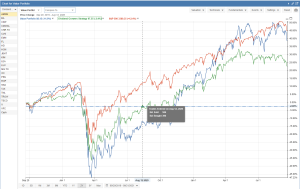
Pricing & Plans:
Stock Rover offers charting features across three plans:
- Essentials: Priced at $7.99 per month, the Essentials plan provides comprehensive charting capabilities with 5 years of detailed financial history.
- Premium: Priced at $17.99 per month, Premium includes all Essentials features plus advanced charting with 10 years of financial history, 100+ chartable financial metrics, and advanced alerting.
- Premium Plus: Priced at $27.99 per month, Premium Plus builds on Premium with even more metrics, historical data screening, and sophisticated charting options like valuation charts, ratio charts, and multiple metric charting.
For more details, visit Stock Rover Plans.
|
Pros |
Cons |
|
|
|
| • Free version | • Steep learning curve |
| • Wide range of charts available | • No macro charting |
| • Compare stocks | • Limited customizability |
| • Basic fundamental charting | |
| • Technical charting |
Summary:
The Stock Rover platform excels in portfolio management and performance tracking. However, its focus on detailed data analysis might present a steep learning curve for beginners. While it caters well to long-term investors and those focused on fundamental analysis, users primarily interested in real-time trading might find it less suited to their needs.
TrendSpider
Platform: TrendSpider is an all-in-one trading platform that offers a comprehensive suite of tools for traders. It includes smart charting capabilities, real-time scanners, robust backtesting, dynamic alerts, and automated analysis. Additionally, TrendSpider provides trading bots for automation and strategy development tools without requiring any coding knowledge.
Charting: TrendSpider is an automated technical analysis tool that uses AI algorithms to assist traders in identifying trends and patterns on stock charts. It features customizable indicators, advanced backtesting, and real-time market data, catering to both novice and experienced traders.
Functionality:
- US stocks
- Technical charting
- Highly customizable
- Compare stocks
- Multiple indicator styles
- Automated charting
- Annotation
- Pattern recognition
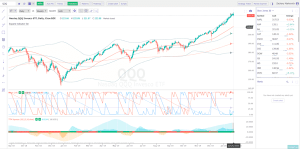
Pricing & Plans:
TrendSpider offers one plane:
- Trendspider: Priced at $149, this plan offers comprehensive charting capabilities with maximum workspace, unlimited scanning results, and extensive backtesting depth.
For a detailed comparison of features, please visit TrendSpider Pricing.
|
Pros |
Cons |
|
|
|
| • Automated charting and indicators | • No free version |
| • Unique alternative data | • No fundamental charting |
| • Technical charting | • Steep learning curve |
| • Highly customizable | • No international coverage |
Summary:
TrendSpider is an advanced charting software that leverages AI for automated technical analysis, offering efficiency and precision for traders. Investors can benefit from its user-friendly interface, customizable indicators, and automated trendline detection, which streamline the analysis process. However, the platform has a steep learning curve for beginners and a subscription cost that may be prohibitive. With no international data, this platform is not suited to global investors. Additionally, reliance on automated analysis might limit deeper market insights.
TIKR
Platform: TIKR is a financial data platform that offers individual investors the essential suite of tools for stock analysis, monitoring watchlists, and following top investors. Data coverage spans more than 100,000 global stocks across 92 countries and 136 exchanges. The platform caters to individual investors and enthusiasts, at an affordable price.
Charting: TIKR allows investors to conduct basic fundamental charting to visualize financial statement items and valuation multiples. While customizability is limited, investors can toggle between reporting periods and display units.
Functionality:
- Global database of stocks
- Compare stocks
- Basic price indicators
- Fundamental charting
- Multiple indicator styles
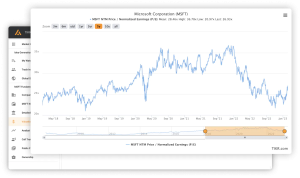
Pricing & Plans:
TIKR offers three pricing plans:
- Free: The free plan offers investors limited data for US companies only, charting capabilities with 5 years of historical data and financial history.
- Plus: Priced at $19.95 per month, TIKR’s Plus plan broadens the data to global companies, extending the historical data and financial history to 10 years and 3 years of estimates.
- Pro: Priced at $39.95 per month, TIKR’s Pro plan has all of the Plus features in addition to the most advanced charting with 20 years of historical data, 5 years of estimates, and additional valuation metrics.
For more details on the rest of the data in TIKR’s pricing plans, visit their website.
|
Pros |
Cons |
|
|
|
| • Free version | • Free plan only covers US stocks |
| • Global base of stocks | • No technical charting |
| • Basic fundamental charting | • No chart templates |
| • Compare multiple stocks | • Lacks customizability |
| • Reporting periods | • No macro data |
| • Cumbersome design | |
| • End-of-day pricing for international stocks |
Summary:
The TIKR terminal is a superb, cost-effective, platform for researching stocks. While TIKR offers basic fundamental charting to users, charting is not one of the platform’s core strengths; as they lack a single dedicated charting software. Users can visualize basic price data in a security’s overview page, and fundamental charting is available for visualizing data picked from the financials section. The absence of technical charting, alternative assets to stocks, macro data, and customizability means that TIKR is suitable for investors with basic fundamental charting needs, but not robust enough elsewhere.
Yahoo Finance
Platform: Yahoo Finance is a versatile platform that provides a variety of financial data, news, and tools for investors. The platform provides real-time stock quotes, charting, financial news, data analytics, daily trade ideas and a personal finance section covering a wide range of topics from retirement planning to mortgage rates.
Charting: Yahoo handles the basics very well, allowing investors to chart simple price-based information, compare stocks, alter intervals and time ranges, and annotate their charts. This all comes with a global database of stocks and a blend of live and delayed pricing data.
Functionality:
- Global database of stocks
- Live / delayed global pricing
- Compare stocks
- Basic price indicators
- Intervals
- Annotation
- Multiple indicator styles
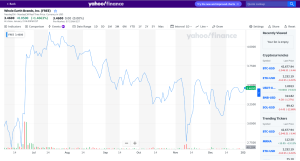
Pricing & Plans:
Yahoo Finance offers three pricing plans:
- Free: offers basic charting features which include standard line and bar charts for stock price history, basic technical indicators, and simple tools for personal portfolio tracking.
- Plus Lite: Priced at $25 per month, while detailed charting features are not specifically listed, it includes daily trade ideas, fair value analysis for stocks, and advanced portfolio performance analysis tools, which may imply some level of charting capabilities.
- Plus Essential: Priced at $35 per month, this plan includes enhanced charting with automatic pattern recognition and the ability to plot significant developments with interactive charts.
For more details on the rest of the data in Yahoo Finance’s pricing plans, visit their website.
|
Pros |
Cons |
|
|
|
| • Live / Delayed global pricing data | • No fundamental charting |
| • Global base of stocks | • No chart templates |
| • Simple and intuitive | • No color customization |
| • Ease of use | • No macro data |
| • Useful for novice investors | • Lacks customizability |
Summary:
While Yahoo Finance is great at handling the basics, it lacks the flexibility, breadth, and depth of alternative charting software. It also lacks the ability to create chart templates for perspectives that investors like to create frequently. As such, Yahoo Finance is great for quickly looking up performance and intraday pricing, but isn’t equipped to handle much more.
StockCharts
Platform: StockCharts caters to individual investors and traders with its advanced financial analysis and data visualization tools. It offers two primary charting platforms: SharpCharts and StockChartsACP. These platforms are versatile, supporting a wide range of technical indicators and overlays, customizable layouts, and various data views for enhanced chart analysis.
Charting: StockCharts offers advanced charting software for technical analysis, including various chart types and customizable indicators. It provides interactive tools and historical data for market analysis and backtesting. Perfect for traders specializing in technical trading strategies.
Functionality:
- Technical charting
- Macro data
- Multiple asset classes
- Compare stocks
- Intervals
- Annotation
- Multiple indicator styles
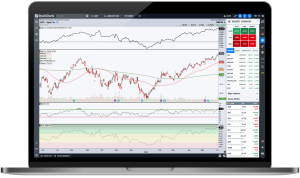
Pricing & Plans:
StockCharts has a free plan and three paid plans:
- Free: provides basic charting features, including one chart per layout, six price datasets per chart, and the ability to save and annotate charts.
- Basic: Priced at $19.95 per month, Basic includes 3 indicators and overlays per chart with a maximum chart width of 900px.
- Extra: Priced at $29.95 per month expands to 25 indicators and overlays per chart with 1600px max chart width.
- Pro: Priced at $49.95 per month also offers 25 indicators and overlays but with a larger max chart width of 2500px and additional features like user-defined indexes and historical chart galleries.
For a detailed comparison of the features included in each plan, visit StockCharts Pricing.
|
Pros |
Cons |
|
|
|
| • Sentiment indicators | • No free version |
| • Wide range of charts available | • No fundamental charting |
| • Market scanning tools | • Steep learning curve |
| • Compare stocks | • Limited international coverage |
| • Custom dashboards |
Summary:
StockCharts is a comprehensive charting software platform widely recognized for its robust and versatile charting tools. It offers a wide range of chart types, including candlestick charts, line, and bar charts, catering to various trading styles. Key features include customizable technical indicators, advanced charting options, and user-friendly interactive tools for detailed market analysis. The platform also provides historical data, which is crucial for trend analysis and backtesting strategies. While it excels in technical analysis, StockCharts may have limitations for those seeking extensive fundamental analysis data. Its user interface, while powerful, may require a learning curve for new users.
Finchat
Platform: Finchat is the birth child of two previously separate sister platforms: Finchat and Stratosphere. The company has successfully integrated the AI capabilities of Finchat with the financial data and analytical strengths of Stratosphere. The result is a unique financial research platform that is both powered and assisted by the use of artificial intelligence. Finchat is particularly suited to individual investors with affordable pricing and AI assistance but also caters to professionals through a rich spectrum of fundamental data and analytical tools.
Charting: Finchat’s charting strengths reside in the fundamental spectrum, where they allow investors to visualize company earnings and valuation multiples. Users can toggle between reporting currencies, reporting periods, units, and build stock charts to compare multiple stocks across multiple metrics.
Functionality:
- Global database of stocks
- Compare stocks
- Fundamental charting
- Multiple indicator styles
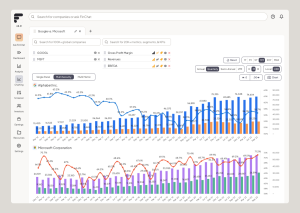
Pricing & Plans:
Finchat offers three pricing plans.
- Free: Finchat’s free plan includes charting with 5 years of annual and 6 quarters of financial data.
- Plus: Priced at $29 per month, the Plus plan expands charting to 10 years of annual and 12 quarters of financial data, with 5 years for segments & KPIs.
- Pro: Priced at $79 per month, the Pro plan contains everything in the Plus plan, in addition to offering extensive charting with 20 years of annual and 40 quarters of financial data, over 10 years for segments & KPIs and custom chart branding.
For more details, you can visit Finchat Pricing.
|
Pros |
Cons |
|
|
|
| • Global base of stocks | • No technical charting |
| • Simple and intuitive design | • No chart templates |
| • Custom chart branding | • No macro data |
| • Compare multiple stocks | • No ETF and Mutual Fund data |
| • Free version | • Price data is from yesterday’s close |
| • No intraday charting | |
| • Limited data in free version |
Summary:
Finchat exclusively caters to equities and fundamental charting with no macro or alternative assets and an absence of technical charting indicators. That said, the fundamental charting offers simple and intuitive design, with some customizability and the ability to compare multiple stocks across a wide range of fundamental indicators. Investors who subscribe to the Pro plan can also unlock branded charting. Because Finchat’s pricing data is one day-delayed, the platform is better suited to fundamental investors who are less interested in real-time pricing.
Editorial note
Our insights are derived solely from historical information and analyst predictions, employing an impartial approach. Please note that our articles do not serve as financial guidance.
